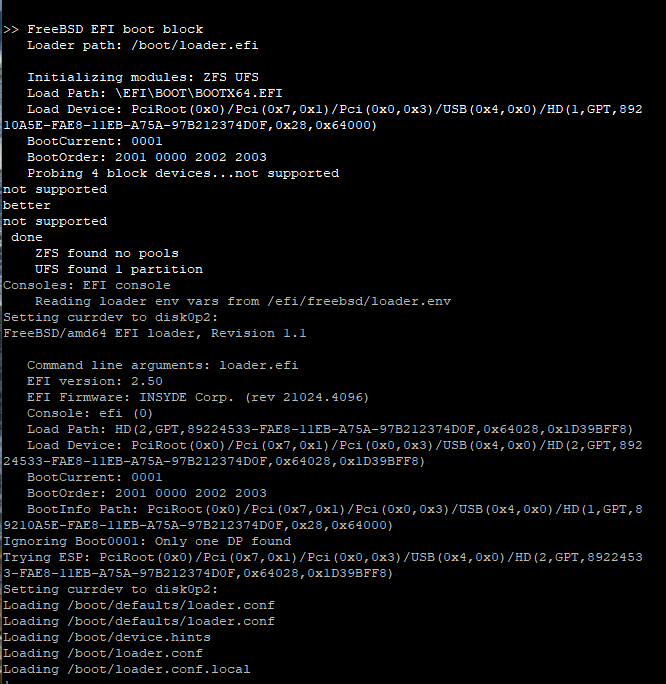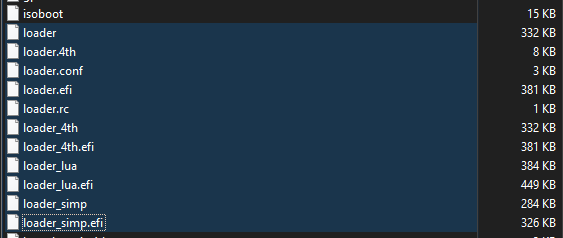PFSense on a DEC3840 (Netboard A20)
-
@stephenw10 I am using the memstick serial image. As this box does not have any video out. I installed PF on the drive using a VM and a usb to nvme adapter with no problem. When i connect it to the DEC3840 i get the following error and it doesnt go any further:

This is what is seen when loading:

-
That's the last thing you see before it loads the loader values. So that will happen if those values change the console baud rate or the port it's listening on.
Did you set it up on the VM using a serial console?Can you not boot the USB installer on the device itself?
Steve
-
@stephenw10 no i installed PF on the drive with the dvd iso on the VM, i see that isnt serial or vga specific, i can try installing it with a usb serial image next.
I can't boot to my install thumb drive, I get the same behavior when attempting to boot directly from the USB on the 3840. it just stalls at that screen.
-
@stephenw10 after some tweaking in the bios and using a sata m.2 drive, i am able to get OPNSense installed, but PFSense still hangs...
-
If you install from ISO in a VM you would need to at least enable the serial console there before moving the drive across.
Are you sure you used the memstick serial image when you booted on it directly?
Are you connected to it at 115200bps?It may have an uncommon serial port location. Check what loader values opn puts on there. They may be enabling the console on com2 for example.
Steve
-
@stephenw10 Yes i am positive I used the memstick serial version of the image, I created a build stick multiple times on different thumb drives, same issue.
Yes I have putty set to com6 115200 8n1.
I found this link showing what OPNSense is using for a serial connection, it looks pretty similar to PFSense's documentation:
https://docs.opnsense.org/manual/how-tos/serial_access.html
https://docs.netgate.com/pfsense/en/latest/hardware/connect-to-console.html
-
Both of those are are for generic serial consoles. But, for example, out RCC-VE devices from some years ago require a special installer because the console there in on com2.
The output you're seeing there implies that device also requires some custom loader values because as soon as it loads the default values it stops showing anything.If there is anything special required it would be in /boot/loader.conf or /boot/loader.conf.local in the opn install.
Steve
-
@stephenw10 forgive me, but what is the best way to view the contents of a img file?
After writing to a thumb drive, i am unable to see the contents of it.
-
I would install from it, then check the loader files in the resulting install.
Steve
-
@stephenw10 below is the opnsense loader.conf after a serial install. do you notice anything that PFSense does differently?
############################################################## This file was auto-generated using the rc.loader facility. In order to deploy a custom change to this installation, please use /boot/loader.conf.local as it is not rewritten, or better yet use System: Settings: Tunables from the GUI. ############################################################## loader_brand="opnsense" loader_logo="hourglass" loader_menu_title="" autoboot_delay="3" - Vital modules that are not in FreeBSD's GENERIC - configuration will be loaded on boot, which makes - races with individual module's settings impossible. carp_load="YES" if_bridge_load="YES" if_enc_load="YES" if_gif_load="YES" if_gre_load="YES" if_lagg_load="YES" if_tap_load="YES" if_tun_load="YES" if_vlan_load="YES" pf_load="YES" pflog_load="YES" pfsync_load="YES" - dynamically generated console settings follow comconsole_speed="115200" #boot_multicons boot_serial="YES" #kern.vty console="comconsole" - dynamically generated tunables settings follow hw.ibrs_disable="0" hw.ixl.enable_head_writeback="0" hw.syscons.kbd_reboot="0" hw.uart.console="io:0x3f8,br:115200" kern.ipc.maxsockbuf="4262144" kern.randompid="347" net.enc.in.ipsec_bpf_mask="2" net.enc.in.ipsec_filter_mask="2" net.enc.out.ipsec_bpf_mask="1" net.enc.out.ipsec_filter_mask="1" net.inet.icmp.drop_redirect="1" net.inet.icmp.icmplim="0" net.inet.icmp.log_redirect="0" net.inet.icmp.reply_from_interface="1" net.inet.ip.accept_sourceroute="0" net.inet.ip.intr_queue_maxlen="1000" net.inet.ip.portrange.first="1024" net.inet.ip.random_id="1" net.inet.ip.redirect="0" net.inet.ip.sourceroute="0" net.inet.tcp.blackhole="2" net.inet.tcp.delayed_ack="0" net.inet.tcp.drop_synfin="1" net.inet.tcp.log_debug="0" net.inet.tcp.recvspace="65228" net.inet.tcp.sendspace="65228" net.inet.tcp.syncookies="1" net.inet.tcp.tso="1" net.inet.udp.blackhole="1" net.inet.udp.checksum="1" net.inet.udp.maxdgram="57344" net.inet6.ip6.prefer_tempaddr="0" net.inet6.ip6.redirect="1" net.inet6.ip6.use_tempaddr="0" net.link.bridge.pfil_bridge="0" net.link.bridge.pfil_local_phys="0" net.link.bridge.pfil_member="1" net.link.bridge.pfil_onlyip="0" net.link.tap.user_open="1" net.local.dgram.maxdgram="8192" security.bsd.see_other_gids="0" security.bsd.see_other_uids="0" vfs.read_max="32" vm.pmap.pti="1" -
The only thing there is this:
hw.uart.console="io:0x3f8,br:115200"But that's the expected default value.
Is there a loader.conf.local?
-
@stephenw10 these are all the files that begin with "loader", i dont see a loader.conf.local

-
What's in device.hints? You can see it's loading that too.
Steve
-
# $FreeBSD$ hint.fdc.0.at="isa" hint.fdc.0.port="0x3F0" hint.fdc.0.irq="6" hint.fdc.0.drq="2" hint.fd.0.at="fdc0" hint.fd.0.drive="0" hint.fd.1.at="fdc0" hint.fd.1.drive="1" hint.atkbdc.0.at="isa" hint.atkbdc.0.port="0x060" hint.atkbd.0.at="atkbdc" hint.atkbd.0.irq="1" hint.psm.0.at="atkbdc" hint.psm.0.irq="12" hint.sc.0.at="isa" hint.sc.0.flags="0x100" hint.uart.0.at="isa" hint.uart.0.port="0x3F8" hint.uart.0.flags="0x10" hint.uart.0.irq="4" hint.uart.1.at="isa" hint.uart.1.port="0x2F8" hint.uart.1.irq="3" hint.ppc.0.at="isa" hint.ppc.0.irq="7" hint.atrtc.0.at="isa" hint.atrtc.0.port="0x70" hint.atrtc.0.irq="8" hint.attimer.0.at="isa" hint.attimer.0.port="0x40" hint.attimer.0.irq="0" hint.acpi_throttle.0.disabled="1" hint.p4tcc.0.disabled="1" -
Hmm, nothing unusual there either.....

-
@stephenw10 do you have any other idea why the installer won't load? Is there any bios settings i should look for? Is there anyway to do a more verbose install?
-
You can interrupt the boot loader just before it gets to that point and force it to boot verbose at the prompt:
OK> boot -vWhat NICs does that have?
If you install to the SSD in something else then move that across before the first boot it will come up normally if there is a profile for the NICs. So you would be able to hit the webgui even if the console doesn't work.Steve
-
@stephenw10 It has 4 Intel I210s and 2 AMD SFP+ ports. OPNSense looks like it load the ax drivers for them. Does PFSense support those? I can try disabling them in the bios for the PF install.
I installed pf on a donor machine and put the drive in the DEC3840, same issue. It hangs on loading the kernel. I tried disabling the SFP+ ports as well, no change in outcome.
-
@stephenw10 Also, looks like there is another loader.conf in the /boot/defaults directory:
Not sure if it shows anything else there...
-
Yeah, if it didn't have drivers for the ax NICs it should still boot completely with igb0 as WAN and igb1 as LAN. Assuming you didn't configure any interfaces on the install box before moving it.
In that case this looks like not a console problem at all bit actually hanging booting the kernel for some reason. Might be time to check the FreeBSD forum for anything known for that CPU/platform. Or dig in the OPN code when they introduced it for any defaults they changed.
Steve